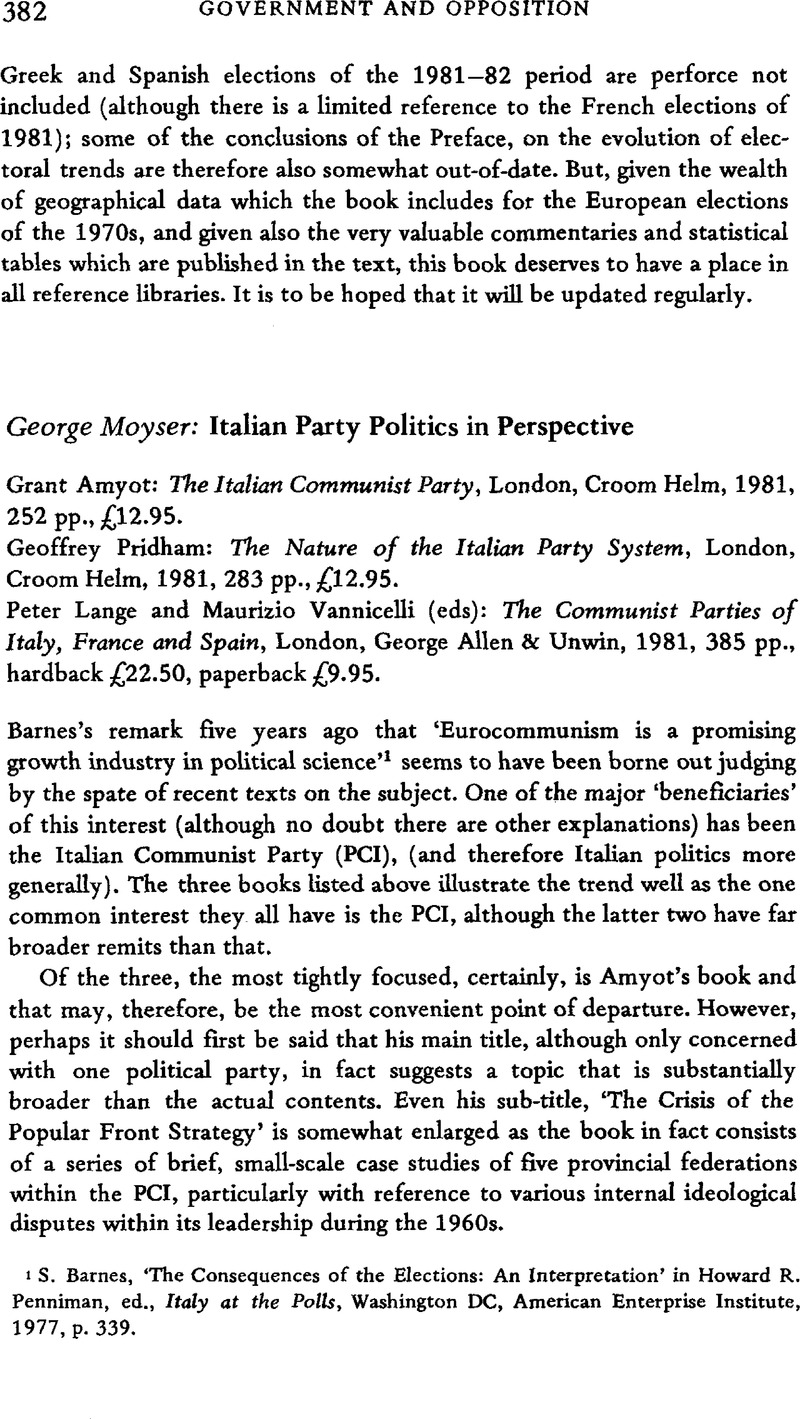No CrossRef data available.
Article contents
Italian Party Politics in Perspective - Grant Amyot: The Italian Communist Party, London, Croom Helm, 1981, 252 pp., £12.95. - Geoffrey Pridham: The Nature of the Italian Party System, London, Croom Helm, 1981, 283 pp., £12.95. - Peter Lange and Maurizio Vannicelli (eds): The Communist Parties of Italy, France and Spain, London, George Allen & Unwin, 1981, 385 pp., hardback ,£22.50, paperback £9.95.
Published online by Cambridge University Press: 28 March 2014
Abstract

- Type
- Reviews
- Information
- Copyright
- Copyright © Government and Opposition Ltd 1983
References
1 Barnes, S., ‘The Consequences of the Elections: An Interpretation’ in Penniman, Howard R., ed., Italy at the Polls, Washington DC, American Enterprise Institute, 1977, p. 339.Google Scholar
2 Some classics include, Eldersveld, Samuel, Political Parties: A Behavioral Analysis, Chicago, Rand McNally, 1964 Google Scholar; Duverger, Maurice, Political Parties, London, Methuen, 1954 Google Scholar; and of particular relevance to Italy Sartori, Giovanni, Parties and Party Systems, Cambridge, Cambridge University Press, 1976 Google Scholar. None of these are cited in Amyot’s bibliography.
3 To a lesser degree this problem also afflicts Pridham’s book.
4 See his footnote 1 to ch. 1.
5 Findings are published regularly in Euro‐Baromètre, Commission of the European Communities, Brussels; the six‐monthly surveys are carried out in Italy by the Istituto per le Ricerche Statistiche e I’Analisi dell’Opinione Pubblica (DOXA), and are available through the European Consortium for Political Research, University of Essex, England. Of course there are many other specialized but relevant surveys of mass political opinion in Italy, particularly of national elections.
6 See Euro‐Baromdtre, No. 17, June 1982, p. 11 and Graph 2. It should, however, also be stated that, if such comparisons are possible, Italy has had consistentty the lowest rating on the index of satisfaction with democracy of any of the 10 countries now covered by the EEC survey.
7 See Pridham’s Table 4.1, p. 139 which shows that only 9 per cent of the population were members, and no doubt many of those were either totally inactive or even fictional. For a discussion of political involvement and its associated characteristics, see Barnes, S., Representation in Italy, Chicago Press, 1977, Ch. 6.Google Scholar
8 Barnes, S., Party Democracy, Yale University Press, 1967.Google Scholar
9 Pridham’s Table 5.1 of coalitions in Tuscan local politics since 1975 shows, by my re‐calculation, that the PSI was involved in 68 per cent of the 296 communal administrations, the PCI in 76 per cent and the DC in only 23 per cent. Of course the figures would be very different if calculated on a national basis.
10 The book‐length version is set out in Inglehart, R., The Silent Revolution: Qlanging Values and Political Styles Among Western Publics, Princeton, Princeton University Press, 1977 Google Scholar. For a recent report concerning the entry of radical young middle class individuals into the lower ranks of party hierarchies (a phenomenon referred to by Pridham on p. 66), see his ‘Post‐Materialism in an Environment of Insecurity’, American Political Science Review, 75, 1981, pp. 880–900.


